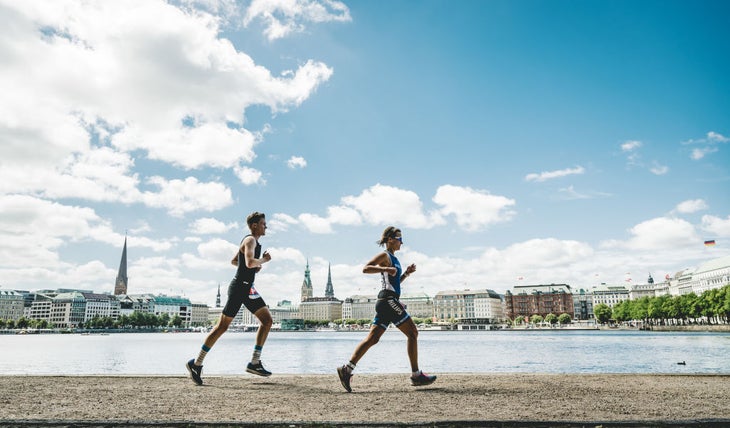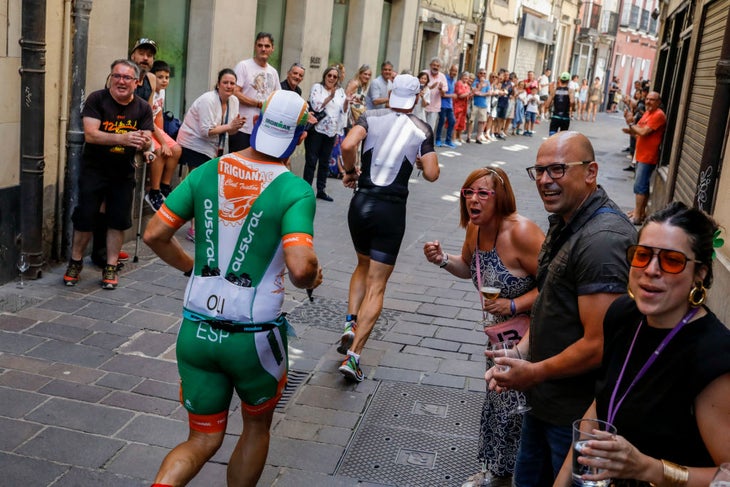New perk! Get after it with local recommendations just for you. Discover nearby events, routes out your door, and hidden gems when you sign up for the Local Running Drop.
We all have that story: “I wore [insert random piece of clothing here] for my first tri, and I couldn’t ride a bike for a week afterwards.” Or maybe it was “run for a week afterwards”; or maybe it was “take a shower without screaming.” We’ve all done a tri with the wrong clothing and felt the repercussions. The perfect tri suit could save your butt, literally.
Today’s tri suits are more than just a pair of spandex shorts with a nice pad and a top with some pockets. Now we have suits designed in the wind tunnel and ones woven with special fabrics that reduce heat, increase evaporation, and help with compression. What’s worth spending money on and what’s not? Are more pockets always a good thing? We’ll begin with the most important and move on from there.
RELATED: The Best Tri Kits of the 2023 Season
The Pad
Let’s start where the metaphorical rubber meets the road. The quality of the pad in your tri shorts is a big deal because it protects and cushions your underparts during the bike, but it also needs to vanish (in a way) on the run. Too little pad on the bike and, if your seat isn’t great, you’ll be in trouble; too much pad on the run, and you’ll face some epic chafing.
Typically if you’re a newer triathlete and you haven’t spent as many hours on the bike, or if you’ve traditionally struggled with pain on long rides (which could also be solved with a different saddle or position, but that’s another story for another day), then go for a thicker pad and know it might feel a little bulky on the run. If you’re a longtime veteran and you never have issues on long rides, go with a thinner pad to avoid chafing that could come when running—which can sometimes even alter your stride and create other issues.
It’s also important to remember that pad thickness isn’t the only dimension to consider: Pad area is worth noting as well. If you tend to move around on your seat, it’s worth getting something with more area; if you stay put, go with less, as it’ll give less opportunity for chafing later. Many brands also have pad shapes designed more specifically for women in their women’s tri suits—something to consider if you’re a female triathlete who can’t find comfort in traditional male-shaped chamois.
Finally, most brands have their own pad material, but you should always look for fewer seams, sewn down as flat as possible, and never (ever) get a pad made of fleece—especially if you’re racing in sandy water. Trust us.
RELATED: How to Find the Right Bike Shorts for You

One-Piece or Two-Piece?
In importance, this is a close second to pad construction—and feuds have been fought over the one- or two-piece tri suit question. A one-piece suit has the top attached to the bottom, and a two-piece keeps the top entirely separate from the shorts. Of course, there are hybrid suits that act like both, but we’ll call them one-piece suits for our purposes.
One piece is typically better for aerodynamics, cooler courses (sometimes), and coverage (important if sunburn is a major issue for you). A two piece is more customizable when it comes to fit, can be better in warmer temperatures (sometimes), and is much (much) easier to deal with when you need to use the restroom. (More on that below.) However, many people don’t like the way two-piece suits ride up or down, while some quite simply don’t like the fit of a one piece.
At the end of the day, most brands offer both options, but you’ll typically find the most high-end tri suits only available in one piece these days. Why? The best aerodynamics are achieved with a one-piece tri suit, so if speed is your greatest concern, you may find yourself in a one-piece regardless of preference.
Pitstop Ease
This is one of those things you don’t think about, until it’s all you can think about. For those who prefer to wear a two-piece tri suit, you can skip this section entirely, because you’re “good to go,” but if you’re interested in a one-piece suit, you need to practice how (and if) you can use the restroom in your suit. A few of today’s newer one-piece suits come in a hybrid-cut design, which allows you to easily use the bathroom without taking the whole thing off, but otherwise, you’ll likely be peeling off that top and wrestling it back on if nature calls.
Heat/Water Dissipation
This is pretty important. While most brands typically have their own proprietary fabrics, usually a thinner fabric will not only cool faster, but it’ll also dry quicker. In other words, a thinner fabric will evaporate your sweat faster to keep you cool, but it’ll also soak up less water in the swim—which can counterintuitively serve to keep you from getting too cold on windier or chillier days. Also, a suit’s ability to evaporate water quickly can help prevent chafing.

Pockets
Though pockets aren’t necessarily essential to a good tri suit, being realistic about how much you’re going to carry, when you’re going to carry it, and what you’ll be wearing during the swim is important. Beginning with the swim, know that any pockets opening upward (toward your head) will create drag in the water if they don’t have flap covers, are cut at an angle, or aren’t covered by either a wetsuit or a speedsuit/swimskin. If you’re wearing either a wetsuit or swimskin, then the construction of your pockets is irrelevant. But if you’re swimming in just your tri suit, then make sure your pockets aren’t slowing you down.
On the bike, be realistic about if you’re going to store nutrition in your suit or on your bike itself. If your strategy is the former, then make sure you can reach your pockets while you’re riding—while in the aerobars if you can. Practice this before race day. Finally, think about how much you really want to carry on the run—which is when most triathletes utilize tri suit storage on race day. The size and number of your pockets should reflect exactly what you want to bring and how long your race will be.
Aerodynamics
Even though a triathlete’s body is the largest single cause of drag on your entire cycling setup (it is!), that doesn’t mean that aerodynamics should be prioritized over all else. Comfort is still important—especially if you’re not racing for a podium spot. But if you want to maximize aerodynamics on that giant wind sail known as your body, you should be wearing a tight-fitting suit with elbow-length sleeves. While sleeves will keep you warmer in cold races (and can sometimes heat you up in hot ones), they’re also one of the first things that the oncoming wind will hit as you ride. As such, a suit with aerodynamically optimized sleeves will always be faster than your bare forearms, no matter how sleek you might think you are.
